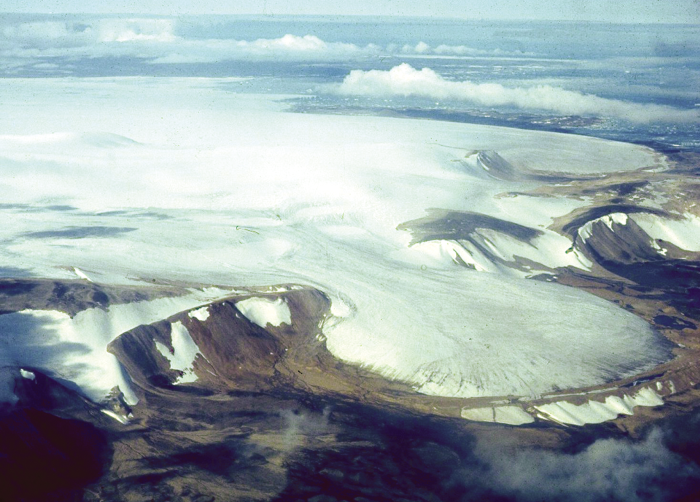



永久凍土は熱的条件であり、その形成、存続、または消失は気候に大きく依存します。その分布、温度、および厚さは、地表の熱的レジームの変化を引き起こす自然環境の変化と人為的擾乱に反応します。気温や降水量の変化、または植生の除去、絶縁有機層の除去、森林火災、河川の移動、海岸線の浸食による地表の擾乱はすべて、地表の熱的レジームの変化を引き起こす可能性があります。
地上の気候と地下の気候の相互作用は複雑で、いくつかの要因に依存します。地上の気候の変化は、植生、有機物、積雪の断熱効果により、地下で緩和されることが多いです。通常、地表の温度変化と深部の永久凍土の変化の間には時間差があります。厚い永久凍土の場合、この時間差は数百年から数千年、薄い永久凍土の場合は数年から数十年です。
カナダ地質調査所 (GSC) がマッケンジー地域で行っている継続的な監視プログラムは、永久凍土と気候の相互作用の研究に重点を置いています。現在存在するすべての永久凍土が現在の気候と平衡状態にあるわけではありません。ボーフォート海の沖合にある永久凍土は数百メートルの厚さがあります。これは、最終氷期に棚が冷たい空気温度にさらされたときに形成されました。この永久凍土は現在、ボーフォート海の水温と不均衡な状態にあり、徐々に劣化しています。
大循環モデルは、人為的発生源により大気中の二酸化炭素濃度が倍増すると、北極圏の大部分で年間平均気温が数度上昇すると予測しています。地表温度が融解温度から 1 ~ 2 度以内である不連続永久凍土地域では、地球温暖化に伴う地表温度の変化により、永久凍土は最終的に消滅する可能性があります。地表の氷の含有量が多い場所では、この永久凍土の劣化は物理的な影響を及ぼします。最も懸念されるのは、融解時に不安定になる可能性のある土壌 (融解沈下、クリープ、または斜面崩壊) です。このような不安定性は、景観、生態系、およびインフラに影響を及ぼす可能性があります。適応策が必要かどうかを判断するには、気候変動が永久凍土に与える影響を評価する必要があります。
カナダ永久凍土監視ネットワークは、活動層と永久凍土の熱状態の長期的フィールド観測を提供します。この観測は、現在の永久凍土の状態を理解し、永久凍土の陸上気候信号とその時間的および空間的変動を検出するために不可欠です。このネットワークは、永久凍土に関する世界陸上ネットワークと、世界気象機関の地球気候観測システムの下で体系的な氷圏観測を提供するカナダの義務に貢献しています。GSC は、ネットワークのフレームワークとインフラストラクチャの調整と実装を担当しています。約 75 の熱監視サイトが政府と大学の科学者によって運営されています。
GSC は 20 か所を超える温度監視サイトのネットワークを維持しています。ボーリング ホールの深さは一般に 20 メートルです。これらは 1980 年代半ばにマッケンジー渓谷とデルタに設置され、その一部はカナダ環境省およびカナダ農業省と共同で運営されています。GSC はまた、マッケンジー地域で解凍管を使用して 60 か所の活動層監視サイトのネットワークを運営しています。GSC は、カナダ軍基地 (CFS) アラートの 5 つのボーリング ホールを含む、高緯度北極圏の永久凍土温度観測所のネットワークを維持しています。
1970 年代後半、ヌナブト準州のエルズミーア島北端の CFS アラート (82.5°N、62.4°W) に 5 つの永久凍土地温ボーリング ホールが設置されました。1978 年以来、これらのサイトでは、永久凍土の地温が最大 60 メートルの深さまで手動で測定されています。ボーリング ホールは、世界で最も北に位置する永久凍土の地温監視サイトであり、最近設立された永久凍土に関する世界陸上ネットワークへの重要な貢献となっています。23 年間のデータ セットは、カナダの永久凍土温度に関する最も長い記録の 1 つです。ボーリング ホールは、国防省 (DND) と GSC が共同で管理しています。
2002 年、GSC は、カナダ環境省の積雪監視ネットワークと協力し、キャンベル サイエンティフィックの気象センサーを設置しました。これらのセンサーは、気温、風速、超音波積雪深センサーで構成され、GSC の各施設に、アラートの高緯度北極圏施設に 3 か所、ベーカー レイクの低緯度北極圏施設に 1 か所、マッケンジー渓谷のリグレー近くの北方林施設に 1 か所設置されています。センサーは CR510 データロガーを使用して測定され、ステーションへの訪問頻度が低いため、外部の SM4M ストレージ モジュールが追加のデータ ストレージを提供します。電源は、10 W のソーラー パネルで充電される 26 Ahr のバッテリーによって供給されます。長い極夜を通して確実に動作させるには、バッテリーの大容量ストレージが必要です。2003 年の夏には、他の GSC 施設にさらに多くのステーションを設置する予定です。これらの気象ステーションは、各サイトの積雪の空間的および時間的変動と局所的な微気候に関する情報を提供します。生成されたデータは、カナダの氷圏が気候変動と変動性にどのように反応するかについての理解を深めるために使用されます。
アラートの気候は、高緯度北極諸島のほとんどで見られる寒冷な極地砂漠気候の典型で、寒くて乾燥しています。年間平均気温は -18.1°C、年間平均地表温度は約 -16°C です。降水量の 30 年間の標準値は 16.2 mm で、年間平均総降水量は 153.6 mm です。永久凍土の厚さは 600 m を超えます。
この地域では積雪は一般的に薄いか全くありませんが、空間的および時間的に大きな変動を示します。積雪は、気温の変化に対する浅い永久凍土の温度の反応に影響を与える重要な要因です。気象データは、気温の変化に対する永久凍土の反応に影響を与える地域の微気候の役割の分析に役立ちます。
ケーススタディの概要
アプリケーション
永久凍土研究地点の気象状況の監視場所
カナダ、北極圏諸島使用製品
CR510 SM4M寄稿者
Daniel Riseborough and Sharon Smith, Hazards & Environmental Geology Subdivision, Dept. of Natural Resources, Canada参加団体
カナダ国防省地質調査所計測項目
気温、風速、積雪深関連ウェブサイト
GSC Permafrost WebsitePDFで見る